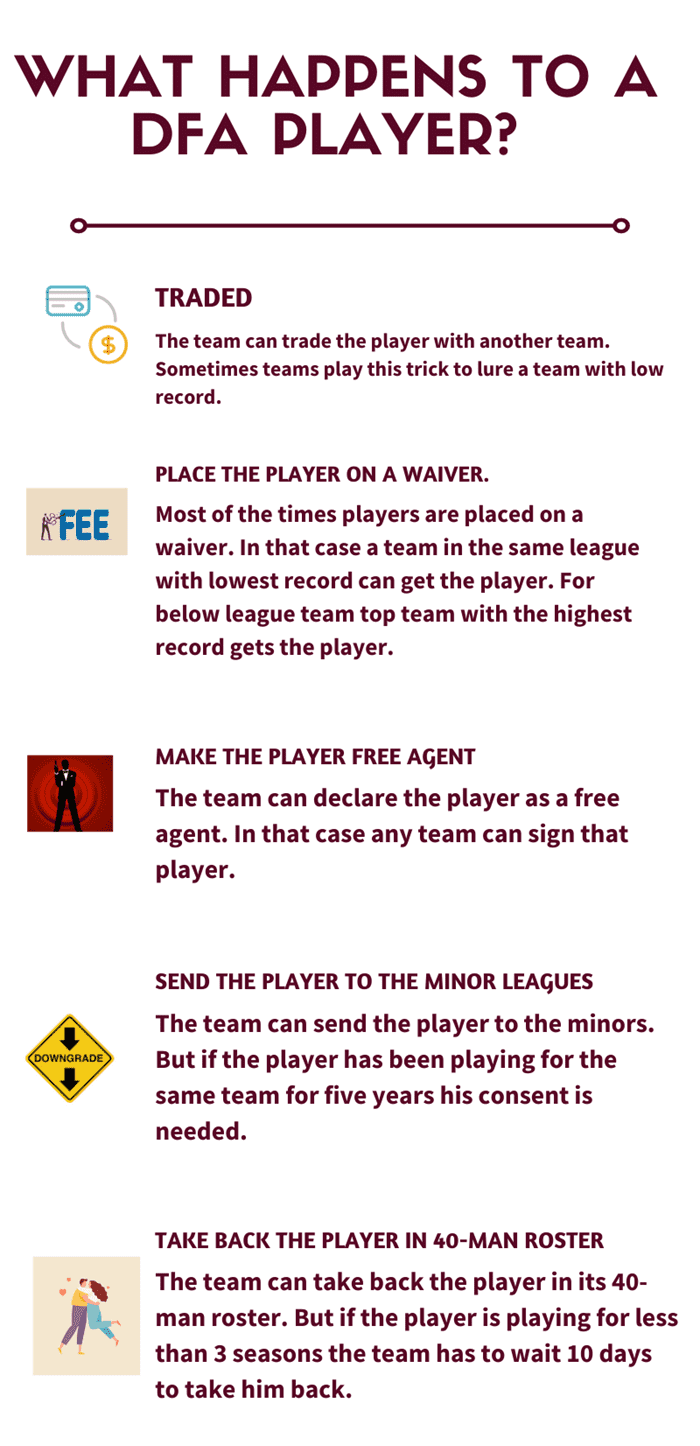The letters DFA represent one of the more commonly used acronyms in Major League Baseball. DFA stands for Designated for Assignment and it refers to a procedural move teams can make to remove players from their 40-man roster.
Understanding how and why teams utilize the DFA designation provides insight into roster construction strategy in MLB. It also highlights the precarious position many professional players find themselves in, with their career hanging in the balance of front office decision-making.
While fans may see DFAs simply as players switching teams, the reality is much more complex, with careers put on the line every time a DFA occurs. The nuances of baseball’s waiver wire and contract systems come into play after a DFA, and no two situations play out exactly alike.
For teams, DFA decisions represent a balancing act between managing the 40-man roster, addressing team needs, and handling player acquisitions and departures. For players, a DFA starts a process filled with uncertainty over their future.
So what exactly does DFA entail, what are the implications, and why does this transaction hold such importance? Read on to learn more about the DFA process and how it impacts teams and players across Major League Baseball.
What Does DFA Stand For?

DFA stands for “Designated for Assignment”. It is a term used in Major League Baseball (MLB) that refers to when a player is removed from a team’s 40-man roster.
The full phrase “Designated for Assignment” indicates that a player has been designated, or selected by the team, to be placed on irrevocable waivers – meaning other MLB teams have an opportunity to claim the player’s contract. If the player clears waivers without being claimed by another team, they are then assigned to one of the club’s minor league teams.
So in summary, “DFA” is an acronym for “Designated for Assignment”. When a MLB team DFA’s a player, they are designating them to be placed on waivers and potentially assigned to the minor leagues if they go unclaimed. This allows teams to open up roster spots for other players.
How DFA Works in MLB
In Major League Baseball (MLB), DFA stands for “Designated for Assignment”. It is a process that allows teams to remove a player from their 40-man roster while opening up a roster spot for another player.
Here’s how the DFA process works in MLB:
-
When a team wants to remove a player from their 40-man roster, they designate that player for assignment. This is usually done because the team wants to call up another player from the minor leagues who is not currently on the 40-man roster.
-
Once a player is DFA’d, the team has 7 days to either trade, release, or place that player on irrevocable outright waivers.
-
If the player clears waivers unclaimed by other teams, he can be outrighted to the minor leagues. However, the player has to accept the outright assignment. If he refuses, the team has to release him.
-
If the player is claimed off waivers by another team during the 7-day period, his new team is awarded the contract and places him on their 40-man roster.
-
Players with 3+ years of MLB service time can refuse an outright assignment and elect free agency if they clear waivers.
So in summary, DFA gives teams an avenue to remove players from their 40-man roster while opening up spots for new additions. It allows flexibility for GMs to shuffle their rosters and call up prospects while maintaining control of the DFA’d player. However, other teams can claim the player on waivers, taking the decision out of the original team’s hands.
Why Teams Use DFA

There are several main reasons why MLB teams designate players for assignment:
-
Poor Performance – If a player is consistently underperforming and hurting the team, a DFA gives management an opportunity to remove them from the active roster. Veterans in decline or prospects/role players who aren’t panning out are often DFA candidates.
-
Open Roster Spot – DFA opens a spot on the 40-man roster to add another player. Teams may need to clear space to call up a prospect or sign a free agent. DFA is an effective way to shuffle the roster.
-
Addition By Subtraction – Struggling teams sometimes DFA underperforming veterans to give opportunities to younger players. Removing a regressing player from the clubhouse or lineup can lift team morale and performance.
-
Salary Relief – Teams with tight budgets utilize DFA to clear high-priced contracts. If the player goes unclaimed, their contract can be moved off the books.
-
Spark Change – Managers may DFA an underperforming player to send a message to the rest of the team. The threat of losing your job can motivate other players.
-
Last Resort – Players with chronic injuries, disciplinary issues, or steep declines are often DFA’d when the team runs out of patience and options. DFA serves as a final change before release.
The strategic use of DFA gives teams flexibility to address performance issues, roster construction, financial constraints, and team culture. For struggling veterans, DFA represents the end of the road.
What Happens After DFA
After a player is designated for assignment (DFA), there are a few possible next steps:
-
Waivers – The DFA’d player is first placed on irrevocable waivers, giving other teams an opportunity to claim the player’s contract. About 50-60% of DFA’d players will end up being claimed on waivers. If a team claims the player, they assume the remainder of his contract.
-
Trade – If the player passes through waivers unclaimed, the DFA team has 10 days to trade, release, or outright the player to the minors. About 15-20% of DFA’d players are traded during this period.
-
Released – If the 10-day period expires and no trade is completed, the team can release the player to free agency. This happens to around 30% of players who go through the DFA process.
-
Outrighted – The DFA team can also choose to outright the player to the minor leagues if he clears waivers. This removes him from the 40-man roster while keeping him in the organization. About 5-10% of DFA’d players are outrighted rather than released.
So in summary, around half of DFA’d players are claimed on waivers by another team. The other half either get traded, released, or outrighted during the 10-day DFA period after passing through waivers unclaimed. This allows teams some flexibility in handling an unwanted player on their 40-man roster.
Notable DFAs

The DFA process has led to some controversial and impactful roster moves over the years.
Here are some of the most famous examples:
-
Johan Santana – In 2003, the Minnesota Twins DFA’d two-time Cy Young winner Johan Santana when he was out of minor league options. Santana cleared waivers and stayed with the Twins, going on to become one of the most dominant pitchers in baseball over the next several seasons. This demonstrated how even superstar players can potentially be DFA’d due to roster constraints.
-
Josh Hamilton – In 2004, the Tampa Bay Devil Rays DFA’d top overall draft pick Josh Hamilton when injuries and drug problems kept him off the field. After spending years out of MLB, Hamilton eventually recovered, became an All-Star with the Texas Rangers, and won AL MVP in 2010. This showed the risk of giving up on talented players too soon via DFA.
-
Jose Bautista – In 2008, the Blue Jays DFA’d struggling utility player Jose Bautista, who then went unclaimed. After changing his swing, Bautista broke out to lead MLB in home runs in 2010 and 2011. This illustrated how overlooked players can reinvent themselves and have success after being DFA’d.
-
John Axford – In 2018, the Blue Jays DFA’d struggling closer John Axford, who was quickly claimed by the Dodgers and became a key reliever for them on a playoff run that season. Axford’s turnaround highlighted the strategy of contenders poaching DFA players to improve their rosters for the stretch run.
The DFA process has given teams flexibility to open roster spots but has also led to them giving up on valuable players too hastily at times. Teams have to weigh many factors when deciding who to DFA.
DFA Strategy
Deciding when to designate a player for assignment requires careful strategy and planning by the front office.
Teams must weigh several factors when making the DFA decision:
-
Timing – Is this the right moment to cut ties or should the player be given more chances? Making a DFA too soon can be premature, but waiting too long can hurt the team’s competitiveness. Teams try to find the ideal timing.
-
Replacement Plan – Who will take the player’s spot on the roster? Having a solid replacement ready is key. Teams don’t want to create a hole on the roster.
-
Communication – It’s important to communicate professionally with the player prior to DFA. They should hear the news directly from the team, not the media. Teams aim to handle the situation with class, acknowledging the player’s service.
-
Salary/Contract Status – A player’s salary often plays a role in DFA timing. Teams may wait until right before a contract guarantee date before making the move. Financials are a factor.
-
Opportunity Cost – Who else could that roster spot be used for? DFA opens a spot for a prospect or acquisition. Teams weigh this opportunity cost.
-
Production Trends – Has the player been declining or improving? Recent performance and future projections inform the decision. DFA is about more than just stats though.
-
Relationship with Player – Some teams aim to conduct respectful DFAs to maintain goodwill with the player, in case he returns or becomes available later. A bridge shouldn’t be burned.
-
Team Morale – DFA could negatively impact clubhouse morale if not handled properly. Teams seek to make the right choice for the team while still being sensitive.
Proper DFA strategy requires extensive analysis by the front office and thoughtful decision-making. The move can carry heavy implications for the team and player.
Criticisms of DFA

The Designated for Assignment (DFA) process in Major League Baseball has received some criticisms over the years. While it provides teams flexibility in managing their 40-man rosters, it can place players in a state of limbo and uncertainty.
One of the main criticisms of DFA is that it negatively impacts players’ job security. When a player is DFA’d, they are immediately removed from the team’s 40-man roster and placed on waivers. This leaves them vulnerable to being claimed by another team or even becoming a free agent if they clear waivers. Many players who go through DFA ultimately lose their spot on a 40-man roster, leaving their MLB future uncertain.
The DFA process is often described as baseball “purgatory.” Once DFA’d, a player has to wait 10 days or until they are claimed/clear waivers before they know where they will end up. This limbo can be stressful and disruptive for players who suddenly find themselves off a roster. Some critics argue it is unfair for veterans who may get cut loose quickly.
Another downside of DFA for players is that they lose their salary and benefits during this time in limbo. A DFA’d player is no longer on the team’s payroll until they clear waivers and re-sign with the team or join a new organization. This creates financial uncertainty.
While DFA provides necessary flexibility for teams, it is reasonable to acknowledge the job insecurity and uncertainty it creates for players. The 10-day waiver period leaves them in limbo, and many ultimately lose their major league jobs through no direct fault of their own. Understanding these criticisms can lead to ideas on how to potentially improve the DFA system.
DFA Use in Other Sports
DFA is primarily used in Major League Baseball, as the other major professional sports leagues in the United States have somewhat different roster rules and transaction terminology.
The National Football League, for example, does not use DFA designation. NFL teams have a 53-man active roster limit and can release players at any time without needing to designate them in any particular way. Waivers come into play, however, if a player has fewer than 4 accrued seasons in the NFL.
Similarly, the National Basketball Association does not have a DFA designation. NBA teams can release or waive players directly. Waivers are required for players who have played fewer than 3 NBA seasons.
Overall, while DFA is unique to MLB, other leagues have their own protocols for releasing players from the active roster based on service time accrued. The DFA provides MLB teams flexibility to open up roster spots while maintaining some control over the player’s destination.
Conclusion
Understanding what DFA stands for and how it works in Major League Baseball is important for any serious fan of the game. To recap, DFA stands for Designated for Assignment and is a mechanism that allows MLB teams some flexibility in their roster management.
When a player is DFA’d, he is immediately removed from the team’s 40-man roster and another team has seven days to claim him. If the player clears waivers during this period, he can be sent to the minor leagues or released. Teams typically DFA a player when they need to open up a roster spot for another player.
Some notable players who have been DFA’d include Wilmer Flores, Jay Bruce, and Trevor Bauer. While being DFA’d can seem like the end of the road, there are examples of players like Daniel Descalso who have gone on to have productive MLB careers after being designated for assignment.
The DFA process is an important part of roster construction strategy in baseball. Understanding how and why teams use it provides insight into the dynamics between front offices, managers, players, and fans. For devoted baseball fans, knowing the ins and outs of transactions like the DFA demonstrates a deeper level of knowledge about the game.








